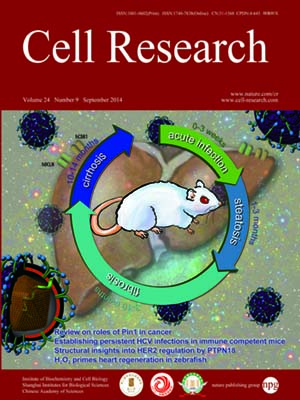
Volume 24, No 9, Sep 2014
ISSN: 1001-0602
EISSN: 1748-7838 2018
impact factor 17.848*
(Clarivate Analytics, 2019)
Volume 24 Issue 9, September 2014: 1050-1066 | Open Access
ORIGINAL ARTICLES
Persistent hepatitis C virus infections and hepatopathological manifestations in immune-competent humanized mice
Jizheng Chen1,*, Yang Zhao2,*, Chao Zhang2,*, Hairong Chen2,*, Jin Feng2, Xiumei Chi3, Yu Pan3, Jun Du4, Min Guo1, Huang Cao1, Honghe Chen1, Zilong Wang1, Rongjuan Pei1, Qian Wang5, Lei Pan2, Junqi Niu3, Xinwen Chen1 and Hong Tang1,2
1State Key Laboratory of Virology and the Center for Viral Pathology, Wuhan Institute of Virology, Chinese Academy of Sciences, Wuhan, Hubei 430071, China
2Key Laboratory of Infection and Immunity, Institute of Biophysics, Chinese Academy of Sciences, Beijing 100101, China
3Department of Hepatology, The First Hospital of Jilin University, Changchun, Jilin 130021, China
4The Institute of Biotechnology, Shanxi University, Taiyuan, Shanxi 030006, China
5Key Laboratory of Human Functional Genomics of Jiangsu Province, School of Basic Medical Science, Nanjing Medical University, Nanjing, Jiangsu 210093, China
Correspondence: Hong Tang, Tel: +86-10-64888438; Fax: +86-10-64848357 E-mail: tanghong@moon.ibp.ac.cn; Xinwen Chen, Tel: +86-10-64888438; Fax: +86-10-64848357(chenxw@wh.iov.cn)
The majority of hepatitis C virus (HCV) infection develops chronic infection, which causes steatosis, cirrhosis and hepatocellular carcinoma. However, understanding HCV chronicity and pathogenesis is hampered by its narrow host range, mostly restricted to human and chimpanzee. Recent endeavour to infect a variety of humanized mice has not been able to achieve persistent HCV infection unless the essential innate immune responsive genes are knocked out. Nevertheless, such immune-compromised humanized mice still lacked HCV infection-induced hepatopathogenesis. Here we report that transgenic mice in ICR background harboring both human CD81 and occludin genes (C/OTg) are permissive to HCV infection at a chronicity rate comparable to humans. In this mouse model, HCV accomplishes its replication cycle, leading to sustained viremia and infectivity for more than 12 months post infection with expected fibrotic and cirrhotic progression. Host factors favorable for HCV replication, and inadequate innate immune-response may contribute to the persistence. Lastly, NS3/4 protease inhibitor telaprevir can effectively inhibit de novo RNA synthesis and acute HCV infection of C/OTg mice. Thus, chronic HCV infection with complete replication cycle and hepatopathologic manifestations is recapitulated, for the first time, in immune-competent mice. This model will open a new venue to study the mechanisms of chronic hepatitis C and develop better treatments.
10.1038/cr.2014.116
FULL TEXT | PDF
Browse 2863


